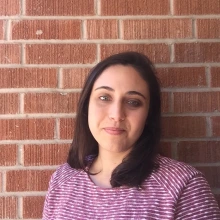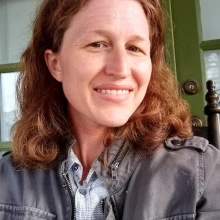2021–2022 SoA Dissertation Fellowships Announced
The School of Anthropology is pleased to announce that the SoA Graduate Fellowships Committee has accomplished the challenging task of selecting among an extraordinary pool of applications to award four full-year dissertation awards for 2021–2022. Congratulations to our fellowship recipients:

Haury Dissertation Fellowship: Caitlin McPherson, “Identifying Plastic Responses in Human Skeletal Tissues through a Sensitive Developmental Windows Framework”
Committee: Drs. Ivy Pike (co-chair), Jim Watson (co-chair), and Mary Stiner
Abstract: Recent research in developmental biology and epigenetics indicates that environmental factors may exert significant influence over processes of growth and development. In particular, the timing and frequency of stress exposures in early life shape both short and long-term phenotypic trajectories, with the potential to enhance resilience in adverse environments in exchange for increased disease susceptibility and mortality risk in adulthood. Since stress experienced during early life may have long-term consequences over the life course, it is essential that biologists develop theoretical and methodological frameworks for assessing when individuals are most vulnerable to stress exposures. My dissertation research seeks to answer the questions: 1) When might individuals be at greater risk for developing long-term consequences from stress experienced in early life?; and 2) Is evidence of stress-mediated plasticity in the skeletal system a reliable indicator of long-term patterns of growth and mortality risk? My research addresses these questions using bioarchaeological methods of assessing developmental stress in the skeletal system and an interpretive framework based on the concept of sensitive developmental windows (SDW).
Sensitive developmental windows (SDW) are periods in early life when energy needs are high, and developing tissues exhibit greater plasticity in response to environmental signals. The skeletal system is relatively modular and composed of elements which grow and develop at different rates, at different periods over the life span. Thus, some elements are more likely than others to capture durable evidence of stress experienced within SDW. This project will improve existing methods of identifying and interpreting evidence of plasticity (developmental responses) in the skeletal system by examining a set of asymmetries in early-differentiating, conservative skeletal elements that capture an extended period of early child development. Individual asymmetry indices derived from these measures will be assessed using childhood mortality rates, age-at-death and adult stature as covariates, so that the impact of plasticity on mortality risk over the lifespan can be evaluated. The key intellectual impact of this project will be the production of a novel framework in which to more clearly define the relationship between early life environments, biology, and health outcomes across the lifespan. Further insights derived from this research about the lifetime impacts of developmental stress will be relevant to researchers in early life biology, human development, and public health.

Haury-Dixon Dissertation Fellowship: Jay Stephens, “Sourcing the Red Gold of Southern Africa: Using Lead Isotope and Trace Element ICP-MS Analyses to Reconstruct the History of Long-Distance Exchange, Interaction, and Mobility in Southern Africa”
Committee: Drs. David Killick (advisor/chair), Emma Blake, Dani Triadan, Isabel Barton (Department of Mining and Geological Engineering)
Abstract: One of the most contentious issues over the last 20 years in the archaeology of Iron Age southern Africa (ca. 4th–19th c. CE) has been the role that long-distance trade from China, India, and the Persian Gulf may have played (or not) in the rise of the first states between the Limpopo and Zambezi rivers after about 1200 AD. Both parties in this debate have almost completely ignored the emergence of states further north – beyond the reach of Indian Ocean trade networks – and the extent of long-distance exchange between these states and the better-known states south of the Zambezi. My dissertation breaks new ground by investigating links within and between these two clusters of states, and focuses particularly on documenting the movement of copper (a material of great value in African societies) through the application of archaeometric techniques to over 230 geological ore samples and 270 samples of archaeological copper metal. The geological samples expand my existing lead isotope database of prehistorically exploited copper deposits which is a critical component in accurately identifying the parent geological deposits for archaeological copper artifacts. These identifications are then used as proxies for mobility and interaction between past people. Archaeological copper samples were collected from sites dating between 300 – 1850 CE and include findspots for large cross-shaped ingots in northern Zimbabwe and southern Zambia, sites under state control as well as those within the traditionally labelled “hinterland” zones between the two clusters, and sites of known copper production throughout the region. The diversity of archaeological material in this study will allow me to assess diachronic patterns of human interaction and mobility associated with copper production and consumption, and how these patterns intersect with issues related to the rise of states, inter-regional connections, and the development of technologies.

Haury-Dixon Dissertation Fellowship: Alena Wigdoner, “Worldviews in Contact: Gendered Symbolic Systems and Votive Offerings in the Roman Northwest”
Advisor: Dr. Emma Blake
Abstract: The Roman worldview, especially with respect to imperial ideology, had gendered dynamics at its center. Maleness represented culture, learning, morality, and control while femaleness represented nature, instinct, uncontrolled emotion, and the need for guidance. Rome sought to impose these male ideals on the troublingly feminine regions it conquered. In the peoples of Britain and Gaul, the Romans saw perversion: not only did women lead tribes and armies, but men consented to women’s leadership without shame. These same men wore a womanish amount of jewelry and habitually engaged in homosexual behavior. In this project, I study the impact of introducing a Roman worldview into this region that the Romans found so different from their own. In a colonial context already shaped by a gendered Roman imperial ideology, how did the Roman worldview impact gender dynamics in Britain and Gaul?
I analyze gendered implications of Roman colonialism through study of votive offerings, objects that individuals offered to deities as pleas or thanks for services rendered. Most studies of gendered implications of colonialism in the region focus on textual or iconographic evidence. In contrast to these lines of evidence, which tend to focus on people of high status or capture the ideal rather than the daily reality, votives represent highly personal actions, accessible across the socioeconomic spectrum, in such symbolically loaded contexts as sanctuaries. Votive offerings in Roman Britain and Gaul, especially offerings of personal objects such as jewelry or work implements, have rarely been studied from a gendered perspective. The result is the persistence of uncritical gendered assumptions concerning these objects first put forth by excavators and scholars in the nineteenth and twentieth centuries.
The basis of this project is examination of published votive assemblages from ten sanctuaries, supplemented by in-person analysis of collections where gaps in publication exist. My analysis incorporates multivariate statistical methods meant to elucidate patterns in complex data. In addition to this large-scale, interregional data analysis, I study two sanctuaries, Uley in the UK and Jublains in France, in more depth. This second scale of analysis allows for qualitative study of the diversity of ritual at individual sanctuaries as well as a spatial analysis of that ritual within the sites. The goal of this approach is to provide a model of the application of multivariate analysis using legacy data to answer highly humanistic questions in the Roman world.

Andrew William Amann, Jr. Award: Rebecca Wey. Rebecca has chosen the three-paper dissertation format, so has no official dissertation title, but offered a project title: “Knowing the unconscious: psychoanalysis and politics in Buenos Aires.”
Committee Chair: Dr. Thomas Park
Project Summary: This dissertation contributes to a long-standing debate about psychoanalysis that, since Foucault, has questioned its relation to politics. In this regard, Argentina has garnered attention as it is a world capital of psychoanalysis, and Buenos Aires is seen to possess a unique “psychoanalytic culture.” My research follows other scholars who try to speak to the shape and import of that culture, investigating the political effects of psychoanalysis as popular knowledge outside the clinic. I find that, against previous claims, it is difficult to account for effects specific to psychoanalysis as such. Instead, I show that it is easily instrumentalized in service of other discourses, or used ad hoc by speakers to make intersubjective alignments. I argue that what appears as psychoanalytic resonance across Argentine society is instead the amplification of an older national problematic that thematizes symbolic fracture. Psychoanalysis, as a discourse of symbolic fracture par excellence, finds virtuous resonance with this problematic, amplifying its effects.
Anthro News Digest date: 04/30/2021

